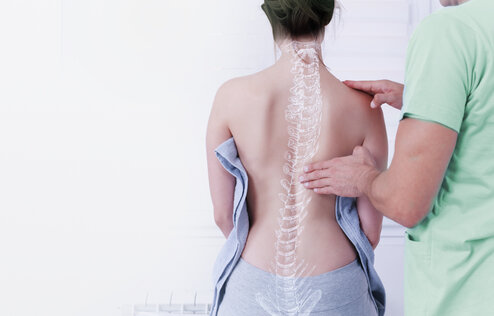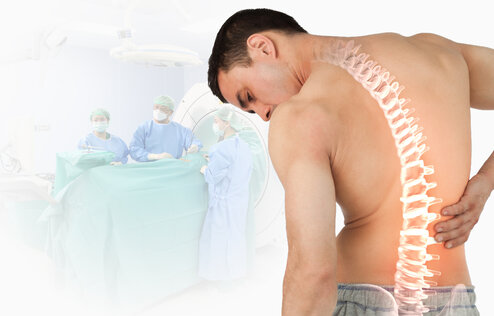Spondylosis : Causes, Symptoms & Treatments You Must Know
Center : Spine Center
Article by : Dr. Bordin Varodomvanichkul

Spondylosis can affect individuals of all ages and genders. Spinal degeneration often begins as early as the 20s and gradually progresses over time, influenced by lifestyle choices and repeated strain on the spine. If you’re experiencing symptoms such as persistent back or neck pain, it’s important to seek medical attention promptly. Early diagnosis allows for appropriate treatment options and helps prevent more serious complications.
Degenerative spinal disease is not limited to the elderly—teenagers and working adults are also at risk. This condition is commonly linked to lifestyle habits that place excessive stress on the spine, accelerating the wear and tear process. While spondylosis is typically found in individuals over the age of 35, cases in younger patients are becoming increasingly common.
If you experience unusual movement, back pain that radiates to the legs, neck pain extending to the arms, or weakness in the hands, arms, or feet, it's crucial to consult a doctor as soon as possible. Delaying treatment may result in more severe symptoms, including spinal instability, displacement, or collapse.
Table of Contents
What is Spondylosis?
Spondylosis is a condition that refers to age-related degeneration of the spine, affecting the spinal discs, vertebrae, and joints. It most commonly occurs in the cervical (neck), thoracic (mid-back), or lumbar (lower back) regions. This condition can lead to symptoms such as chronic pain, stiffness, and reduced mobility, often impacting daily activities and quality of life.
What Causes Spondylosis?
While aging is the primary cause of spondylosis, several other factors can contribute to the development and progression of this spinal condition:
- Degenerative Disc Disease: Over time, the intervertebral discs lose hydration and elasticity, reducing their ability to cushion the spine effectively.
- Bone Spurs: As a natural response to spinal wear and tear, the body may develop excess bone, which can press on nearby nerves and cause pain or numbness.
- Herniated Discs: Weakened or damaged discs can bulge or rupture, leading to nerve compression and associated symptoms such as pain or tingling.
- Genetic Predisposition: Some individuals are genetically more likely to develop spinal degeneration at an earlier age.
- Lifestyle Factors: Poor posture, physical inactivity, repetitive movements, heavy lifting, or past injuries can speed up the degenerative process of the spine.
What are the symptoms of spondylolysis?
Symptoms of spondylosis can vary depending on which part of the spine is affected. However, common signs include:
- Pain: Persistent or recurring pain in the neck or lower back. It may start as mild discomfort but can become chronic over time.
- Neurological Symptoms: Tingling, numbness, or muscle weakness in the arms or legs, often caused by nerve compression resulting from bone spurs or herniated discs.
In some cases, nerve compression in the lower spine can lead to sciatica, a condition characterized by sharp, radiating pain that travels from the lower back down through one leg. Sciatica can significantly impact mobility and daily comfort, and it is a common symptom in individuals with lumbar spondylosis.

What are the most common complications of spondylolysis?
Doctors diagnose spondylosis based on symptoms, physical examinations to assess pain, mobility, and muscle strength, as well as neurological evaluations to check nerve function. Imaging tests such as X-rays, CT scans, or MRI scans of the spine are also used to detect spinal abnormalities.
How is spondylosis diagnosed?
Spondylosis is typically diagnosed through a combination of medical history, physical examination, and imaging tests. The process generally includes:
- Medical History and Symptom Review—The doctor asks about your symptoms, such as neck or back pain, stiffness, numbness, or tingling, as well as any history of injury or underlying conditions.
- Physical Examination—The physician evaluates your range of motion, posture, reflexes, muscle strength, and sensation to detect nerve involvement or spinal cord compression.
- Imaging Tests—These help visualize changes in the spine:
- X-rays: Detect bone spurs, disc space narrowing, or vertebral degeneration.
- MRI (Magnetic Resonance Imaging): Shows soft tissue structures, including discs, nerves, and the spinal cord, helping identify nerve compression.
- CT Scan (Computed Tomography): Provides detailed cross-sectional images of bone structures.
- Other Tests—In some cases of diagnosed spondylosis, electromyography (EMG) or nerve conduction studies are used to assess nerve function and determine the extent of nerve damage
How is spondylolysis treated?
Treatment for spondylosis depends on the severity of symptoms. Doctors may recommend medications such as pain relievers, anti-inflammatory drugs, and muscle relaxants to manage discomfort. Physical therapy is often used to strengthen muscles, improve posture, and maintain flexibility. Lifestyle modifications, including regular exercise, proper ergonomics, and weight management, can help slow disease progression. Alternative therapies like acupuncture, chiropractic care, and massage therapy may provide relief for some patients. In severe cases, when conservative treatments do not alleviate symptoms, surgical procedures such as spinal decompression or fusion may be necessary.
When Does Spondylosis Require Surgery?
Surgery is considered when symptoms become severe and do not respond to conservative treatments. Persistent pain that interferes with daily life, significant nerve compression causing weakness or numbness, and loss of bladder or bowel control due to spinal cord compression are key indicators. If the condition severely affects mobility or leads to complications that impair quality of life, surgical intervention may be necessary to relieve pressure on the spinal cord and restore function.
One common surgical option for treating advanced spondylosis is TLIF (Transforaminal Lumbar Interbody Fusion). This procedure involves removing the damaged disc and fusing the vertebrae to stabilize the spine and reduce nerve compression. TLIF is typically recommended when spinal instability or chronic pain persists despite other treatments, offering patients a chance to regain mobility and improve quality of life.
Conclusion
If you are looking for a spondylosis treatment that promotes fast recovery, minimizes hospital stays, and provides comprehensive medical facilities, Nakornthon Hospital offers advanced solutions tailored to your needs.
Spondylosis is a common condition that can significantly impact daily life. Early diagnosis and appropriate management can help alleviate symptoms and improve quality of life. If you experience persistent back or neck pain, consult a healthcare professional for a comprehensive evaluation and treatment plan. Contact us today for a free consultation.
For more information, please contact:
- - Website : https://en.nakornthon.com
- - Facebook : Nakornthon Hospital - International Patient
- - Line : @nakornthoninter
- - Tel: 02-450-9999 (Available 24 hours)
Free Online Consultation
Article of Spine Center









